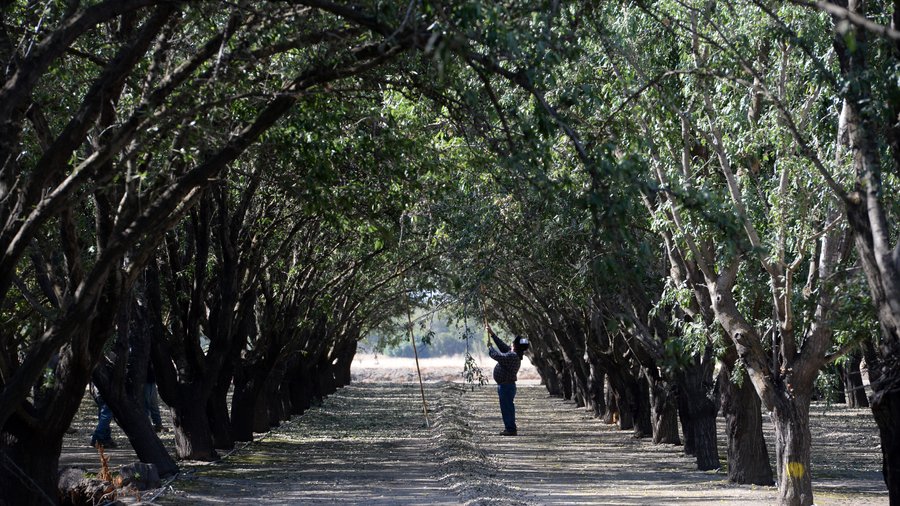Listen to this article 2 min
This article is part of a focus section on challenges facing agriculture in the region.
Times are tough for the almond industry. One of California’s most favored crops has faced a number of challenges in recent years. Trade wars, Covid-19, pests, weather and the war in Ukraine have all taken their toll.
In 2021, almond orchards made up 51,020 acres of farmland in Yolo, Placer and Sacramento counties, representing $161 million in growers’ revenue, according to annual agricultural commissioner reports. But the next year that figure was slashed in half, to $73 million, as almond prices hit their lowest point in 20 years.
“The low prices that almonds are commanding now are the product of two factors that are behind us now, but have lingering consequences,” said Richard Sexton, distinguished professor of agriculture and resource economics at the University of California Davis.
Those factors are the trade war that hit almonds during the Trump administration, and disruptions from Covid-19, which caused unsold supplies of almonds to build up.
“It's all a consequence of people hanging on to their inventories,” Sexton said.
Now, the challenges farmers are facing are taking their toll on investors.
In February a major almond orchard investor filed for Chapter 11 bankruptcy protection. Trinitas Farming LLC is backed by private equity investors out of Redwood City. It was formed in 2015, in the heyday of California’s almond boom. The year before, almond prices hit $4 a pound, according to the U.S. Department of Agriculture, a record high for the crop. Unbeknownst to farmers at the time, however, is that that was as high as prices would get. They’ve been falling ever since.
Trinitas Farming has 17 different almond farms, totaling 7,856 acres of almond orchard, including 3,095 acres in Solano County. It’s now planning to sell those farms to pay off its $188 million in debt. In court documents, Trinitas blames low almond prices and high interest rates for its bankruptcy.
“People who planted and invested anticipating prices in excess of the high prices that we’ve had in the past, and they got highly leveraged in terms of borrowing in order to be able to do this, I would see how stress would be created,” Sexton said. “They are losing money at these prices.”
But it’s not just new-to-the-industry investors who are hurting.
Blue Diamond Growers, the Sacramento cooperative that was founded by almond farmers more than 100 years ago, recently confirmed that it laid off 38 corporate employees as part of a “right-sizing” of its organization.
“Marketplace headwinds coupled with industry challenges have made it difficult for many Blue Diamond growers to remain financially viable," the co-op said in a statement at the time.
Blue Diamond's net revenue also declined 17%, to $1.33 billion in its last fiscal year, according to its annual financial report.
Sexton said that Blue Diamond’s downsizing may also be a result of its changing market share, which has shrunk over the decades that he's been observing the industry.
“When I first came, Blue Diamond had over half the market,” he said. “But its share has diminished significantly since then."
That's happened as almond farms have gotten bigger. Historically, most almond farms in the state were smaller than 100 acres. While that’s still the case, according to the USDA’s agricultural census, the percentage is shrinking as new farms get larger. Over the last 10 years, the number of almond farms that are bigger than 1,000 acres has more than doubled.
“The marketing apparatus of a cooperative like Blue Diamond is especially important for smaller growers,” he said. “Larger growers have less of a need for the kinds of support that Blue Diamond can provide."
Now, Sexton said, Blue Diamond’s specialty is its value-add products like almond milk and flavored snack nuts, while the bigger growers are dominating bulk almond exports.
“It would be rational for Blue Diamond to have less workers as their share of the market has declined,” he said. “That belt-tightening is a reaction to hard times."
Still, Sexton thinks better days are on the horizon, as the market factors that once drove almond prices up are still in place.
"The long-term outlook for demand is still very positive in my view, but there will be lean times until these inventories get back down,” he said.
California still has almost no competition from other countries when it comes to growing almonds. The state produces more than 80% of the world’s almonds. And demand is expected to rise, as the massive populations in India and China grow their economies and develop new tastes for things like almonds.
“Even though China and India are major export markets now, if you look at their per-capita consumption and compare it to the U.S., it's nothing," Sexton said.
With plantings of new almond orchards declining, supply could level out in the long term. In the short term, however, Sexton said growers just have to hang on to their orchards until prices improve.
"It’s a matter of holding on past this dip in the market,” Sexton said.
